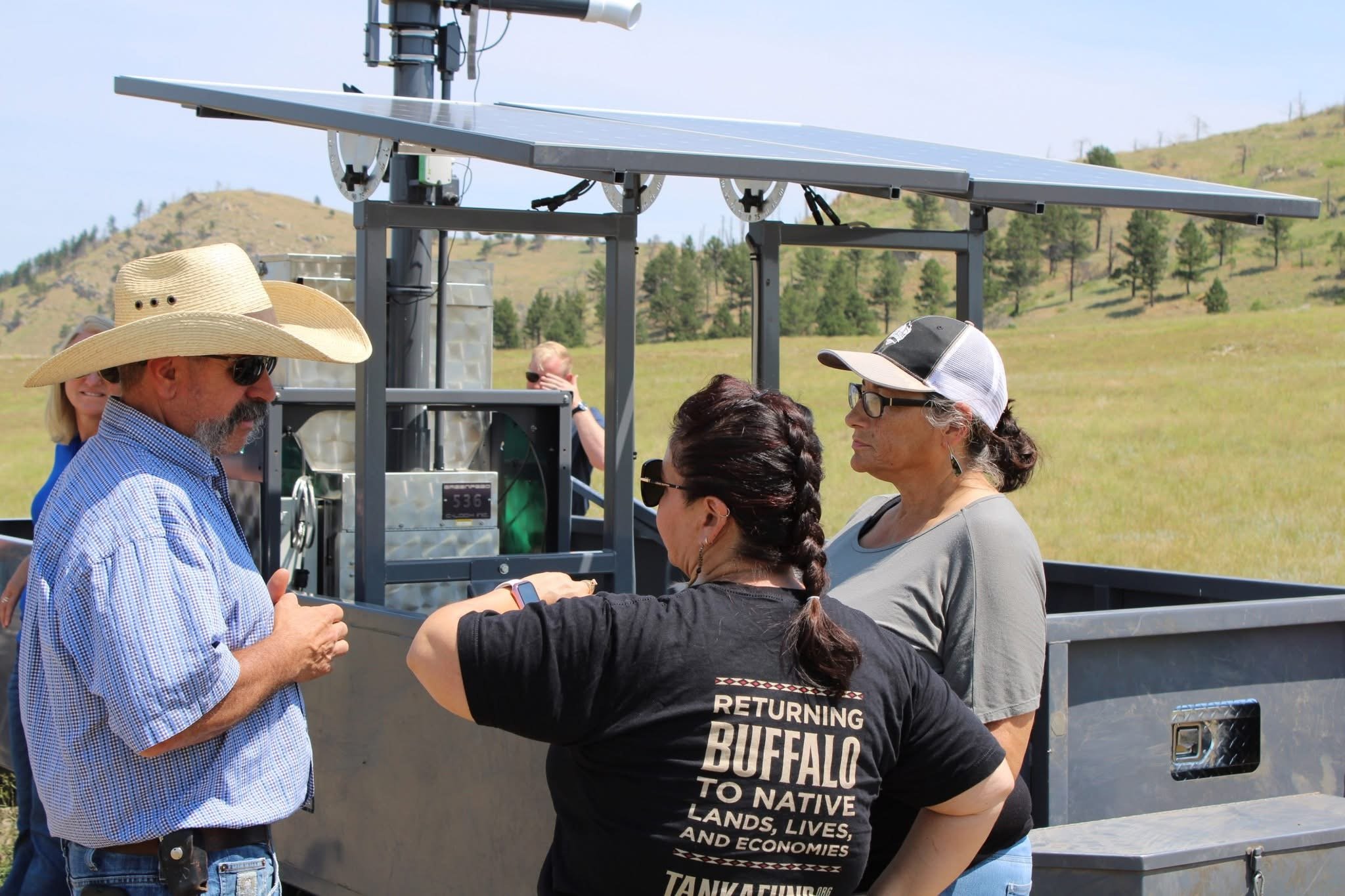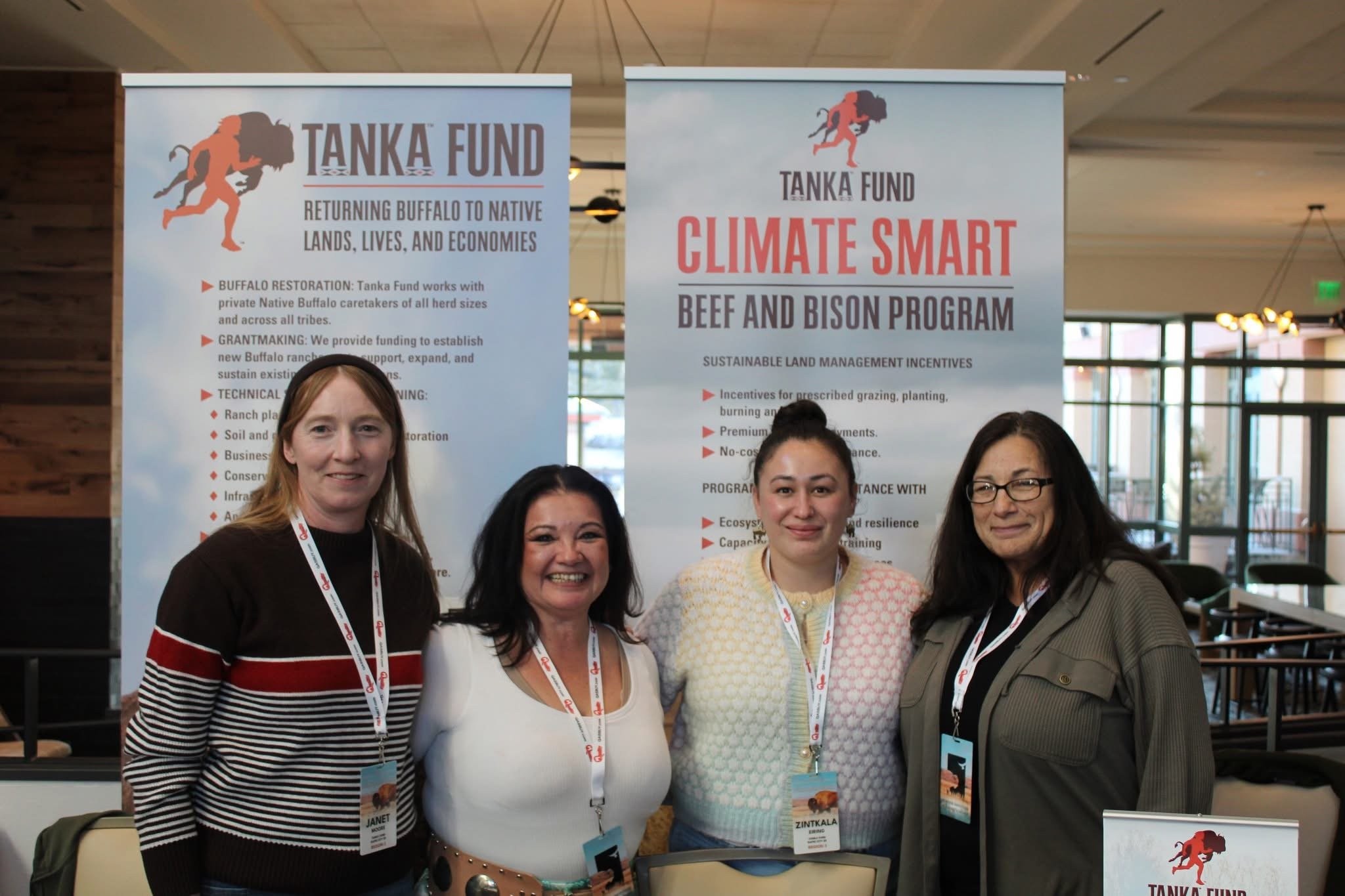What changes when the Buffalo return: A conversation with Tanka Fund Executive Director Dawn Sherman
There’s a sacred bond between Buffalo and Indigenous peoples that reaches back millennia. For over a decade, Tanka Fund has focused on reawakening that bond through catalyzing Native-led Buffalo restoration efforts across diverse Indigenous communities. The impact has been nothing short of profound. It has brought new vitality to the lives of Native people–by revitalizing cultural and spiritual practices once suppressed by colonialism. It has brought new strength to Native economies–by empowering Native-led enterprises grounded in the Indigenous values of reciprocity and sustainability. And it has helped to heal Native lands–by renewing regenerative practice and traditional ecological knowledge that support balance and wellbeing in complex ecosystems.
As the organization launches into its next decade, we spoke with Executive Director Dawn Sherman about what happens when Buffalo are returned to their ancestral homelands and caretakers–and Tanka Fund’s future vision for seeding thriving ecosystems, robust economies, and empowered Native nations.
Since Tanka Fund’s launch in 2014, the organization has done so much to return Buffalo to Native lands–providing support to Native ranchers, driving community and economic development, and bringing back Indigenous land stewardship practices with the power to restore ecosystems. As you look back at it all, have there been moments when you’ve recognized the difference Tanka Fund is making? That your vision is becoming a reality?
“For me, it’s been the moments when we’re on the ground with our partnering ranchers, watching as their Buffalo return to their homelands. Seeing the Buffalo run out onto the prairie, in places where they haven’t lived for well over a century, will give you goosebumps. There are lots of tears of joy, for the ranchers and really for anyone experiencing their return. Those are the moments when I step back and realize–this is what Tanka Fund set out to do. To return our Buffalo relatives to their rightful homes.
Tanka Fund was formed when our founders—the creators of Native American Natural Foods, one of the first companies to introduce regenerative Buffalo meat to a wider marketplace—recognized the critical barriers facing Native ranchers. Their goal was creating an enterprise that could benefit Native economies and communities, but Native ranchers didn’t have the opportunities necessary to be part of that journey. Without access to land, to Buffalo, or to the market, they were left out. Tanka Fund was created to shift that reality.
When I think back on those early conversations that sparked Tanka Fund’s creation as a separate nonprofit, and then flash forward to today–when we’re working with Native ranching partners in eight states across the country–I realize how far we’ve come. Our vision was to bring Buffalo back onto Native lands and into the care of Native ranchers, and we’ve been making that happen for five years now.
None of this would have been possible without our extended community of supporters who believed in our vision from the beginning, who saw that this work will have powerful long-term impacts for Native people, economies, and the land itself. It’s truly an honor to sit in the seat I’m in and to see first-hand the power of our Tanka Fund community.”
You spoke of the moments when Buffalo return to their homes on Indigenous lands. What happens once they make it home–how does their return impact the ranchers who care for them? How does their return affect the communities and economies to which they are connected?
“There are many different shifts that can happen when Buffalo return. It starts with each individual rancher and how they choose to caretake for their Buffalo. We have ranchers who choose to care for small cultural herds with just a dozen or so animals. Their animals aren’t used for commercial purposes; live and die on their homeland. But because of their presence, when there’s an important community event—like someone passing away—they can be used for traditional ceremonies that are vital to community life.”
(Dawn Sherman, center, speaks with Chad Kremer of Kremer Buffalo, a participant in Tanka Fund’s Climate Smart Buffalo program.)
“Other ranchers raise slightly larger herds to support their families as small, independent producers. They make their living by sending a few animals to auction—but also provide animals for traditional Buffalo harvests that end up feeding many community members. We’ve been invited to many traditional harvests–they are sacred gatherings that feed everyone involved. We use a whole carcass utilization approach, so that nothing goes to waste, and everything goes back into the community to nourish individuals and families.
And then we have ranchers who are raising what we call producing–or access to market–herds. These are ranchers with more commercial businesses who are taking on larger contracts, who bring their Buffalo meat into local and regional markets. These ranchers are sparking deeper economic impact in the community, by investing in their businesses, creating jobs, and serving as mentors and examples for young people with an interest in ranching.
Regardless of the scale of each rancher’s approach, the common thread is that their Buffalo bring nourishment to their community–whether economically, spiritually, or culturally.”
What about the land itself–what is the impact on the land as Buffalo return?
“There are significant changes in the land’s health as Buffalo return. Six feet below our feet, there are seed banks just waiting to grow. Because of the way Buffalo wallow, they bring up those seeds, so that native plants and grasses can once again flourish. Eventually, that leads to increased resilience against drought, fires, and flooding. Other wildlife—from the tiniest insects to smaller mammals like prairie dogs and all kinds of birds—benefit as well.”
“Our ranching partners are using traditional ecological knowledge—around grazing and rotating and natural seeding—that protected Indigenous lands and waters for thousands of years. So much of this knowledge comes from what we’ve learned from the Buffalo themselves and how they live on the land. While cattle will often graze right down to the root of a plant, Buffalo don’t do that, giving the plants the ability to regenerate. They seek out the plants they need during particular seasons—like when moms are calving—and leave other food sources for when they’re most needed for survival.
We need this knowledge now more than ever. Restoring our prairies and grasslands is essential in the fight against climate change because of their incredible ability to store carbon. By bringing back Buffalo as a keystone species, and allowing Native ranchers to draw on traditional Indigenous practices to care for them, we are not just protecting individual communities. We’re taking steps that will have an impact on our entire planet.”
As you look forward, where is Tanka Fund going next? What’s exciting for you as you look toward the next decade?
'“We’ve just completed a new strategic plan, thanks to the support of our partners at Emergence. It incorporates a wide range of community perspectives on what Tanka Fund could do in the coming decade to continue to lift up Native lands, lives, and economies. There are so many opportunities–and we’re so grateful to be approaching the next decade from a place of abundance.”
“First and foremost, our work will continue to lift up Native ranchers, to address the systemic disadvantages that still affect them deeply. That includes raising funds to increase the grants we provide, to anywhere from $5000 to $20,000, and help our current ranching partners access more land and take in more animals. We’re continuing to develop relationships with new ranching partners all across the country. And we’re expanding the level of technical assistance we can provide to ranchers–helping them with everything from business development, to becoming USDA certified, and much more.
To support all that work, our vision now is to create a land-based headquarters for Tanka Fund. This facility would represent the first national center devoted to repopulating Buffalo across the country using culturally-grounded, regenerative practices. It would be a space to provide resources and training for ranchers, to engage youth interested in ranching, to hold cultural Buffalo harvests, and to bring partners and funders together to learn about what we do. Above all, it would also be a space for creating community and supporting learning about the power of Buffalo to help us heal, whether it’s lives, lands, or economies. It’s so exciting to envision a gathering space that makes that possible–a place where all would be welcome to understand how we can and will thrive when the Buffalo return.”
Get involved in Tanka Fund’s incredible work!
Learn more by following along on social media and subscribing to Tanka Fund’s newsletter, or watching their incredible videos featuring Native ranchers across the country!
Share Tanka Fund’s story far and wide by posting on your own social media channels, forwarding newsletters, and more.
Donate to help Tanka Fund expand their work to more Indigenous communities! Every dollar will help bring Buffalo back to their homelands and caretakers.
Stunning photography courtesy of the team at Tanka Fund.





